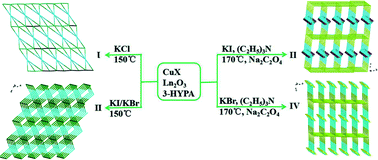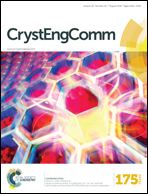Copper(i)–lanthanide(iii) heterometallic metal–organic frameworks constructed from 3-(3-pyridyl)acrylic acid: syntheses, structures, and properties†
Abstract
The first employment of 3-(3-pyridyl)acrylic acid (3-HPYA) in 3d–4f coordination chemistry is reported. Hydrothermal reactions of 3-HPYA with lanthanide oxides and copper halides led to the formation of 17 novel copper(I)–lanthanide(III) heterometallic coordination compounds with four structural types, namely, [Ln(3-PYA)3Cu3Cl3(H2O)2]·H2O [Ln = Dy (1), Eu (2), Gd (3), Tb (4)] (I), [Ln(3-PYA)3CuI(H2O)2]·0.5H2O [Ln = Dy (5), Gd (6), Tb (7), Sm (8)] (II), [Ln(3-PYA)3CuBr(H2O)2]·xH2O [Ln = La (9), Eu (10), x = 1; Sm (11), Nd (12), x = 0.5] (II), [LnCu2(3-PYA)2I2(ox)0.5(H2O)2]·(H2O)2 [Ln = Eu (13), Gd (14), Nd (15)] (III) and [LnCu2(3-PYA)2Br2(ox)0.5(H2O)]·(H2O) [Ln = Gd (16), Tb (17)] (IV) (ox = oxalate). These compounds were thoroughly characterized by single crystal and powder X-ray diffraction, as well as elemental analyses, FT-IR spectroscopy and thermal studies. All the compounds are constructed from halide-containing copper–inorganic motifs and Ln-containing motifs. Compounds of type I are constructed from 1D zigzag Dy–organic chains with [Cu6Cl6] ladder-like clusters, exhibiting a 2D binodal (5, 6)-connected topology. An unusual chemical rearrangement from [Cu6Cl6] to [Cu2Br2]/[Cu2I2] clusters occurs in the formation of type II structures. They are isostructural and exhibit a 3D coordination framework based on dinuclear [Dy2O2] subunits and [Cu2Br2]/[Cu2I2] clusters as nodes, possessing a binodal (4, 6)-connected net. In the type III structure, the Ln–organic motifs propagate along the b-axis, while the Cu–inorganic motifs propagate in the perpendicular direction along the a-axis, both of which are further interconnected to give unique 3D (3, 3, 4, 4, 6)-connected nets with {42·6}2{42·82·1010·12}{43·62·8}4{43}2 topologies. The type IV structure, based on structural analysis results, features a non-interpenetrated 3D coordination framework containing 2D Ln–organic layers and Cu2Br2 chains with a new 5-nodal (3, 3, 4, 4, 8)-connected topology net (point symbol: {42·6}2{43·63}4{43}2{46·610·810·102}). Our present work represents the first example of heterometallic Cu(I) halide–Ln(III)–organic frameworks utilizing 3-HPYA as an organic ligand. The diversity of the products demonstrates that the anion, pH value and reaction temperature have significant effects on the construction of the structures. Moreover, the photoluminescence properties of 2, 4, 7, 10, 12, 13, and 15 and the magnetic properties of 1, 5, and 16 were investigated.


 Please wait while we load your content...
Please wait while we load your content...